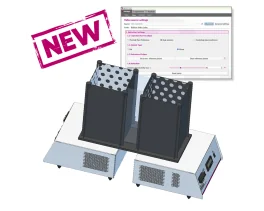Authors
Shaikh S, Shortland P, Lauto A, Barton M, Morley JW, Mahns DA
Lab
School of Medicine, Western Sydney University , NSW , Australia
Journal
Somatosens Mot Res.
Abstract
The effects of changes to cold, mechanical, and heat thresholds following median nerve transection with repair by sutures (Su) or Rose Bengal adhesion (RA) were compared to sham-operated animals. Both nerve-injured groups showed a transient, ipsilateral hyposensitivity to mechanical and heat stimuli followed by a robust and long-lasting hypersensitivity (6-7 weeks) with gradual recovery towards pre-injury levels by 90 days post-repair. Both tactile and thermal hypersensitivity were seen in the contralateral limb that was similar in onset but differed in magnitude and resolved more rapidly compared to the injured limb. Prior to injury, no animals showed any signs of aversion to cold plate temperatures of 4-16 °C. After injury, animals showed cold allodynia, lasting for 7 weeks in RA-repaired rats before recovering towards pre-injury levels, but were still present at 12 weeks in Su-repaired rats. Additionally, sensory recovery in the RA group was faster compared to the Su group in all behavioural tests. Surprisingly, sham-operated rats showed similar bilateral behavioural changes to all sensory stimuli that were comparable in onset and magnitude to the nerve-injured groups but resolved more quickly compared to nerve-injured rats. These results suggest that nerve repair using a sutureless approach produces an accelerated recovery with reduced sensorimotor disturbances compared to direct suturing. They also describe, for the first time, that unilateral forelimb nerve injury produces mirror-image-like sensory perturbations in the contralateral limb, suggesting that the contralateral side is not a true control for sensory testing. The potential mechanisms involved in this altered behaviour are discussed.
Source :

 Pain - Thermal Allodynia / Hyperalgesia
Pain - Thermal Allodynia / Hyperalgesia Pain - Spontaneous Pain - Postural Deficit
Pain - Spontaneous Pain - Postural Deficit Pain - Mechanical Allodynia / Hyperalgesia
Pain - Mechanical Allodynia / Hyperalgesia Learning/Memory - Attention - Addiction
Learning/Memory - Attention - Addiction Physiology & Respiratory Research
Physiology & Respiratory Research











![Dynamic Weight Bearing 2.0 – Postural Module [Add-on]](https://bioseb.com/733-home_default/dynamic-weight-bearing-20-add-on-postural-module.jpg)
























 Pain
Pain Central Nervous System (CNS)
Central Nervous System (CNS) Neurodegeneration
Neurodegeneration Sensory system
Sensory system Motor control
Motor control Mood Disorders
Mood Disorders Other disorders
Other disorders Muscular system
Muscular system Joints
Joints Metabolism
Metabolism Cross-disciplinary subjects
Cross-disciplinary subjects CONFERENCES & MEETINGS
CONFERENCES & MEETINGS